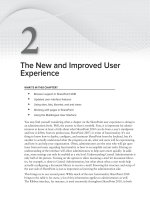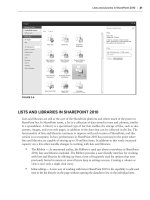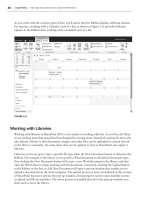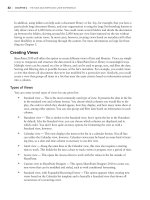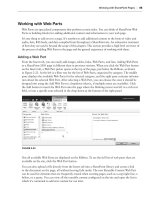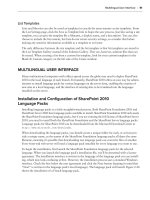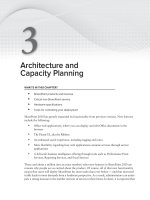Thủ thuật Sharepoint 2010 part 01 pdf
Bạn đang xem bản rút gọn của tài liệu. Xem và tải ngay bản đầy đủ của tài liệu tại đây (587.78 KB, 7 trang )
What’s New in SharePoint 2010
WHAT’S IN THIS CHAPTER?
New installation and upgrade features
Changes to Central Administration
The impact of the Ribbon
It’s been said before, but these are exciting times. We don’t yet have the fl ying cars we were
promised years ago, but we have SharePoint 2010. Seems like a fair trade. When fl ying cars do
come around, I’m sure they’ll be complicated to use at fi rst. SharePoint 2010 is the same; it’s a
little complicated under the hood. Consider this book your mechanic’s guide. The next several
hundred pages will cover the deep technical details that SharePoint administrators will need to
get SharePoint 2010 up and running and purring like a kitten.
This chapter serves as a jumping-off point. It covers some of the bigger changes that SharePoint
2010 has to offer. It’s a teaser to really get you excited about SharePoint 2010, from the admin-
istrator’s point of view. Once your appetite is whetted, you can read up on these topics in more
detail in later chapters, which provide the nitty-gritty details of SharePoint 2010’s functionality.
There’s a lot to get excited about, so we’d better dig in.
INSTALLATION
Of course, before you can see any of the great new things that SharePoint 2010 can do, you
have to install it. This section covers what’s new in the SharePoint 2010 installation process.
System Requirements
Before you can install SharePoint 2010, make sure you meet all of the system requirements.
The minimum requirements for installing SharePoint 2010 are a 64-bit operating system
1
2
CHAPTER 1 What’s NeW iN sharePoiNt 2010
running either Windows Server 2008 with SP2 or later or Window Server 2008 R2. The OS will
need at least .NET 3.5 with SP1 installed as well. On the database back end, SharePoint 2010
requires SQL Server 2005 with SP2 or later or SQL Server 2008. SQL must be 64-bit also.
There is no 32-bit version of SharePoint 2010, not even for demonstration environments. It’s all 64-bit
now. Fortunately, any hardware on which you would install SharePoint 2010 these days is 64-bit capable
.
The 32-bit environment is comfortable, like an old pair of shoes, but now is a great time to move to
64-bit if you haven’t already. In addition to being necessary to run SharePoint 2010, it also brings
a lot of benefits like better CPU utilization and support for RAM over 4GB. Once you start using
SharePoint 2010, you’ll see why that last point is very important. 4GB is the bare minimum of RAM
necessary to make SharePoint 2010 bearable to use, and 6GB is a better starting point.
Installation Options
After the hardware and software is squared away it’s time to start installing some SharePoint bits.
The installer has gotten a facelift and boasts a number of improvements. The process is kicked off
with the friendly splash screen shown in Figure 1-1.
FIGURE 11
Along with installing the SharePoint 2010 software, the splash screen has links to other activities.
The first group of links is documentation to help prepare for the install. This includes guidance on
hardware requirements as well as install and upgrade guides. You might be tempted to skip them,
since you already have this book. However, these links are dynamic, so they will always have the
latest information. We’re flattered you bought the book, but you should read those guides anyway.
The second section of links installs both the SharePoint 2010 bits themselves and any software pre-
requisites your system needs. The prerequisite installer is a really great tool and a welcome addition
to the install process. It will not only download the current version of any software SharePoint 2010
Installation
3
relies on, but also install and correctly configure IIS and other components on your server. It sup-
ports both an unattended mode and installing the prerequisites for a local location, removing the
need to get them from the Internet.
The second link in this section starts the setup for SharePoint 2010. The install process itself isn’t
very different from the SharePoint 2007 install process we all know and love. It supports the stan-
dard guided GUI install as well as the same scripted install options that SharePoint 2007 did. You
can script the installation of the bits by passing the setup process a
Config.xml file with all your
settings. You can then script the configuration of SharePoint 2010 with PowerShell.
While installing SharePoint 2010 is very similar to installing SharePoint 2007, there are a couple
of new twists. First, the install requires a farm passphrase. Just like it sounds, this passphrase is
needed to add or remove a server from a farm. This passphrase is then used as the basis for encryption
between farm members. SharePoint 2007 used the install account for some of this functionality, but
problems arose if the user who installed SharePoint wasn’t available later. The passphrase addresses
that issue.
In addition, the installer now checks for a couple of Group Policy Objects (GPOs) before it installs.
For example, there is a GPO that can be used to block SharePoint installations. This enables a com-
pany to control the proliferation of SharePoint farms in its environment. The installer checks this
GPO to verify that it’s OK to install. If it is, then the install checks for the presence of another GPO
that assigns SharePoint servers to a specific Organization Unit (OU). This enables a common set of
settings for all of your SharePoint 2010 servers, and makes it easy for administrators to keep track
of all the SharePoint farms in their environment. Chapter 4 covers installation in greater depth.
Upgrade and Patching Options
Not everyone will be new to SharePoint. Many people have poured a lot of sweat and blood into
SharePoint 2007 farms. These farms are the backbones of their organizations. In order for SharePoint
2010 to make it into these organizations, the upgrade path will have to be clear and without a lot of
roadblocks. Fortunately, Microsoft also invested a lot into the upgrade experience. They’re under-
standably proud of SharePoint 2010 and have gone to great lengths to ensure that everyone can
install it.
The first glimpse we had of the SharePoint 2010 experience showed up in SP2 for SharePoint 2007.
SP2 included a new STSADM operation,
preupgradecheck. This operation interrogated your
SharePoint 2007 databases and alerted you to any potential roadblocks on your upgrade to SharePoint
2010. It reports on the following key components of your farm:
Servers and amount of content
Search configuration
Features
Solutions
Site definitions
Alternate access mappings
Language packs
4
CHAPTER 1 What’s NeW iN sharePoiNt 2010
It will also alert you to the following potential issues:
Large lists
Orphaned data
Views and content types that use CAML
Databases with modified schemas
The results of the upgrade check are saved to an XML file and an easy to read .HTM file. The check
is read-only, and it can be run multiple times as you clean up issues it discovers.
Not to be outdone, SharePoint 2010 offers the same functionality, at least at the content database
level. The PowerShell cmdlet
Test-SPContentDatabase will interrogate both SharePoint 2007
and SharePoint 2010 content databases and determine whether they can be upgraded and added
to a SharePoint 2010 farm. Like its older brother
preupgradecheck, Test-SPContentDatabase
does not make any changes to your databases, so you can run it without fear on your production
environments.
Upgrade Methods
There are two upgrade methods for upgrading from SharePoint 2007 to SharePoint 2010: in-place
and database attach. The in-place upgrade is just what it sounds like; it upgrades your SharePoint
2007 to SharePoint 2010 on your existing hardware. With the second option, you can attach back-
ups of SharePoint 2007 content databases to a SharePoint 2010 web application and they will be
upgraded automatically.
It may seem like the upgrade options are limited, but the true power lies in the details. Many down-
time mitigation techniques are available that enable use of either of the two upgrade methods with
limited downtime for end users.
The first downtime mitigation feature, support for read-only content databases, made its premiere in
SharePoint 2007 SP2. This feature allows read-only copies of SharePoint 2007 content databases to
be rendered while the actual databases are being upgraded. SharePoint will recognize that the data-
base is read-only and will remove all UI elements that allow users to add or edit content. SharePoint
2010 also supports upgrading multiple databases simultaneously. This reduces upgrade time as long
as the hardware, mainly the SQL servers, can handle the I/O needed to do the upgrades.
If that isn’t enough to keep the users happy, there is a second option. SharePoint 2010 supports redi-
recting traffic to an existing SharePoint 2007 farm during upgrade. This enables users to continue
to use the same URL, but they are given a client-side 302 redirect until the content is available on
SharePoint 2010.
Another feature that will make users happy is Visual Upgrade. Visual Upgrade allows sites upgraded
to SharePoint 2010 to use the SharePoint 2007 master page and CSS. By default, upgraded sites will
maintain the familiar SharePoint 2007 look and feel. A site administrator can view the site with the
SharePoint 2010 interface before finalizing its upgrade. This enables time both for training and for
fixing any pages that will not upgrade gracefully.
Central Administration
5
As if that weren’t enough, the logging experience is also better. Each individual upgrade event gener-
ates its own log fi le, which makes it easy to keep track of what happened. There is also an error-only
log. This greatly reduces the amount of work it takes to determine what went wrong, in the unlikely
event of an upgrade failure.
Patching
You can’t talk about upgrading without also considering patching, which is like a mini upgrade. Not
to be outdone by the improvements to the upgrade process, the patching process has gotten some love
in SharePoint 2010 as well. To give the SharePoint administrator some fl exibility in applying patches,
the patches can be laid down during business hours, but the corresponding database upgrades can
be put off until a time when the downtime is less obtrusive. SharePoint 2010 is also more tolerant of
rolling out patches to the members of a farm. While you won’t want to leave your SharePoint out of
sync for days on end, things will run better in the long run if you leave them that way for a few hours
to apply the patches.
Regarding upgrades, Microsoft documentation sometimes uses the shorthand
V2V for “Version to Version.” In that vein, patching is similarly referred to as
B2B, or “Build to Build.”
How will you know if your SharePoint servers need patching, or your databases updating? Another
new addition to SharePoint 2010, Health Rules, will alert you to these situations. Finally, the patch-
ing team has taken steps to reduce the number of reboots needed when patches are installed. If at all
possible, processes will be stopped to allow fi les to be updated. While we are unlikely to reach a point
when SharePoint doesn’t need to be patched, at least the process isn’t very painful. To fi nd out more
about upgrading and patching SharePoint 2010, turn to Chapter 5 where it is covered in stunning
detail.
CENTRAL ADMINISTRATION
All these administrative improvements to SharePoint 2010 would be worthless if you couldn’t fi nd the
knobs and levers needed to make them work. Therefore, a lot of attention was also given to Central
Administration. Much like the improvements made to the IIS 7 Manager, Central Administration is
now more fl at and wide, instead of deep. As you can see in Figure 1-2, instead of having two tabs
across the top like it did in SharePoint 2007, Central Administration now has links to the most com-
mon tasks on the front page, and eight links on the left if you need to fi nd tasks that aren’t exposed
on the front page. This provides two immediate benefi ts; it makes things easier to fi nd and it results
in fewer mouse clicks to accomplish tasks.
6
CHAPTER 1 What’s NeW iN sharePoiNt 2010
FIGURE 12
To make this design workable, Central Administration has also embraced the Office Ribbon. Once
you drill down to the object you want to work on, the Ribbon shows up on the top of the page with
all the options for that object. Figure 1-3 shows the Ribbon in action.
This enables SharePoint to pack more administrative punch into each page in Central Administration.
As mentioned earlier, this makes links easier to find and requires fewer clicks to find the tasks you
want to accomplish. Another benefit is that you spend less time clicking from page to page to accom-
plish tasks.
On the front page of Central Administration is a heading for each of the eight main areas of admin-
istration, mirroring the areas in the left navigation pane. Under each of these headings are some of
the common links inside each one. For instance, under the Backup and Restore heading is a link
to perform a site collection backup (refer to Figure 1-2). If the task you’re looking for isn’t on the
front page, click the heading, either on the front page or on the left navigation pane, to see all of the
options. Clicking Backup and Restore takes you to a page that shows all of the backup and recovery
options provided with SharePoint 2010 out of the box. The other sections behave the same way. The
front page of Central Administration provides the general topics, while the full complement of spe-
cific options are available when you click the heading link.
Service Applications
7
FIGURE 13
SERVICE APPLICATIONS
Another exciting addition to SharePoint is Service Applications. If you have used MOSS 2007, then
you may be familiar with its Shared Service Provider (SSP) architecture. The SSP was a central ser-
vice that shared common resources with one or many web applications. This enabled SharePoint
to do one crawl, for instance, but provide the search functionality to all the web applications in the
farm without duplicating effort. The SharePoint 2007 SSP was an all-or-nothing affair. Your web
app could only be associated with a single SSP, consuming all SSP services; and it was difficult, if
not impossible, to delegate authority over different parts of the SSP.
Service Applications represent the evolution of the SSP. The SSP model had some pretty common
pain points, which the change to Service Applications addresses. In SharePoint 2010, all the Service
Applications are separate. Examples of Service Applications include Search, Profile Import, Business
Data Catalog and Managed Metadata. This means they can be turned on and off as needed, enabling
you to pick and choose only the ones you are actually using. This saves resources and reduces the
attack vector. Service Applications can also be given their own permissions. This enables you to


